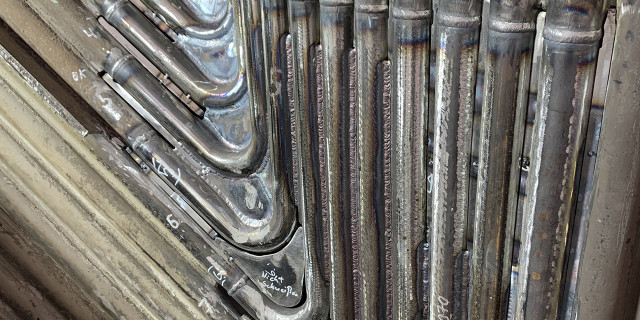
In good hands.
Are you looking for uncomplicated storage and management of your spare parts? We are happy to provide you with the capacity on our production site. In combination with a long-term supply contract, we can also offer you many other options with considerable potential. Depending on the agreement, you can save time and costs for the logistics, procurement and storage of regularly recurring components such as wall and cover panels for the electric arc furnace.
The storage of water-cooled components must be planned in such a way that the storage functions required by the company can be realized, especially with regard to the safety function, e.g. the constant availability of water-cooled spare parts for a melting furnace. We understand our warehousing and spare parts supply to mean the planning of warehouse organization, storage and transport technology, as well as the handling of storage and retrieval together with our customers. The aim of this systematic warehouse planning is, among other things, to reduce storage costs for both sides and to create additional capacity for you. In addition, warehousing can generally help to increase the degree of mechanization and automation.
Efficient warehousing
As a rule, we keep the quantity of spare parts that are in stock at any given time as stock levels. In our view, the following special stocks are important for the organization of warehousing: minimum stock, time of order and current stock as well as maximum or peak stock.
A minimum stock level (also known as safety stock or old stock/stock) is a stock level that must not be undercut, even under extreme circumstances, in order to guarantee the availability of spare parts. The minimum stock level varies depending on the component and/or customer. It generally includes the risk that certain components are subject to greater wear than others. When the time for reordering due to stock-out is reached, a notification is sent to the purchasing department about the reorder - on order - with automatic placement.
The maximum or peak stock level is the maximum amount of stock that can be held in the warehouse to avoid high costs, large capital investments and risks of excessive storage. Optimal stock levels ensure smooth operations and reduce storage costs. Optimal stock levels should match optimal order quantities. For accumulated quantities, minimum and maximum stock levels are dynamic values that can be recalculated based on inventory capacity. This is because when the production intensity of a furnace decreases (increases), the demand for wear parts in the warehouse also decreases (increases) and can even be zero. Therefore, the fixed reporting rate for the cumulative quantity rule does not make sense. However, in order to detect any errors or avoid possible bottlenecks, upper and lower reporting limits can be defined, when these are reached a warning is generated so that you can check whether the line is correct or contains an error (e.g.: data entry or request for calculations).
On request, we can also determine the average storage period, which provides you with information about the situation in the warehouse and the development of the frozen capital in the warehouse. In this way, it shows the average storage duration - and of course the capital required for this - the average stock level. The shorter the shelf life of a component, the better, because storage is costly to operate, takes up space and can make the product more expensive.
Long-term supply contracts
Maintenance and spare parts purchasing must therefore also adapt to the changing market environment. This includes ever shorter lead times, higher availability requirements, greater flexibility, in some cases shorter life cycles and requirement profiles and longer delivery times. Achieving everything by building up reserves inevitably leads to high capital investment and reduced liquidity. On the other hand, ever longer delivery times mean that quickly available spare parts from stock are indispensable. Conflicting interests on the part of the customer must therefore be balanced in advance.
Is there a risk of production downtime because the water-cooled spare parts in operation can no longer be welded? Are you reaching the limits of your own stocks, or is your warehouse overflowing with other components and units that are essential to your operations? We will be happy to help you and arrange a long-term supply contract for external warehousing in Haltern am See, including spare parts delivery. Even if your furnace is getting on in years and has no spare parts drawings, that's no problem for us: send us the defective part or bring it to us so that we can take measurements. We manufacture the spare parts for you in our own workshop and store them. We will be happy to provide you with our fitters, who will remove the defective part on site and install the new part.


